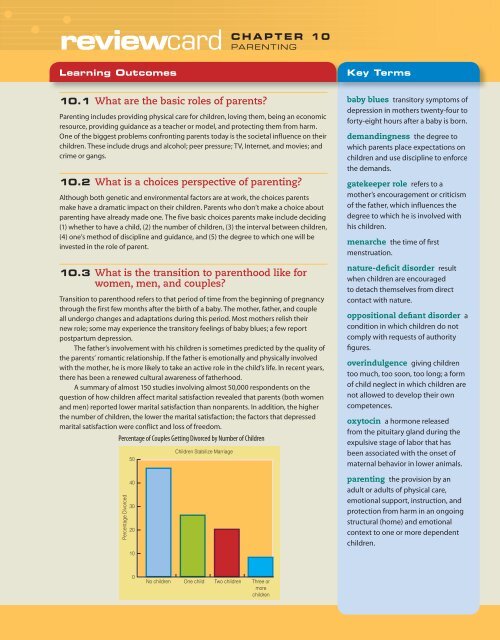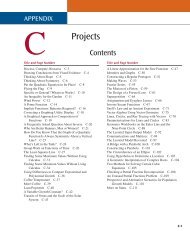10.1 What are the basic roles of parents? - Cengage Learning
10.1 What are the basic roles of parents? - Cengage Learning
10.1 What are the basic roles of parents? - Cengage Learning
You also want an ePaper? Increase the reach of your titles
YUMPU automatically turns print PDFs into web optimized ePapers that Google loves.
eviewcard<br />
CHAPTER 10<br />
PARENTING<br />
<strong>Learning</strong> Outcomes<br />
Key Terms<br />
<strong>10.1</strong> <strong>What</strong> <strong>are</strong> <strong>the</strong> <strong>basic</strong> <strong>roles</strong> <strong>of</strong> p<strong>are</strong>nts?<br />
P<strong>are</strong>nting includes providing physical c<strong>are</strong> for children, loving <strong>the</strong>m, being an economic<br />
resource, providing guidance as a teacher or model, and protecting <strong>the</strong>m from harm.<br />
One <strong>of</strong> <strong>the</strong> biggest problems confronting p<strong>are</strong>nts today is <strong>the</strong> societal influence on <strong>the</strong>ir<br />
children. These include drugs and alcohol; peer pressure; TV, Internet, and movies; and<br />
crime or gangs.<br />
10.2 <strong>What</strong> is a choices perspective <strong>of</strong> p<strong>are</strong>nting?<br />
Although both genetic and environmental factors <strong>are</strong> at work, <strong>the</strong> choices p<strong>are</strong>nts<br />
make have a dramatic impact on <strong>the</strong>ir children. P<strong>are</strong>nts who don’t make a choice about<br />
p<strong>are</strong>nting have already made one. The five <strong>basic</strong> choices p<strong>are</strong>nts make include deciding<br />
(1) whe<strong>the</strong>r to have a child, (2) <strong>the</strong> number <strong>of</strong> children, (3) <strong>the</strong> interval between children,<br />
(4) one’s method <strong>of</strong> discipline and guidance, and (5) <strong>the</strong> degree to which one will be<br />
invested in <strong>the</strong> role <strong>of</strong> p<strong>are</strong>nt.<br />
10.3 <strong>What</strong> is <strong>the</strong> transition to p<strong>are</strong>nthood like for<br />
women, men, and couples?<br />
Transition to p<strong>are</strong>nthood refers to that period <strong>of</strong> time from <strong>the</strong> beginning <strong>of</strong> pregnancy<br />
through <strong>the</strong> first few months after <strong>the</strong> birth <strong>of</strong> a baby. The mo<strong>the</strong>r, fa<strong>the</strong>r, and couple<br />
all undergo changes and adaptations during this period. Most mo<strong>the</strong>rs relish <strong>the</strong>ir<br />
new role; some may experience <strong>the</strong> transitory feelings <strong>of</strong> baby blues; a few report<br />
postpartum depression.<br />
The fa<strong>the</strong>r’s involvement with his children is sometimes predicted by <strong>the</strong> quality <strong>of</strong><br />
<strong>the</strong> p<strong>are</strong>nts’ romantic relationship. If <strong>the</strong> fa<strong>the</strong>r is emotionally and physically involved<br />
with <strong>the</strong> mo<strong>the</strong>r, he is more likely to take an active role in <strong>the</strong> child’s life. In recent years,<br />
<strong>the</strong>re has been a renewed cultural aw<strong>are</strong>ness <strong>of</strong> fa<strong>the</strong>rhood.<br />
A summary <strong>of</strong> almost 150 studies involving almost 50,000 respondents on <strong>the</strong><br />
question <strong>of</strong> how children affect marital satisfaction revealed that p<strong>are</strong>nts (both women<br />
and men) reported lower marital satisfaction than nonp<strong>are</strong>nts. In addition, <strong>the</strong> higher<br />
<strong>the</strong> number <strong>of</strong> children, <strong>the</strong> lower <strong>the</strong> marital satisfaction; <strong>the</strong> factors that depressed<br />
marital satisfaction were conflict and loss <strong>of</strong> freedom.<br />
Percentage <strong>of</strong> Couples Getting Divorced by Number <strong>of</strong> Children<br />
Percentage Divorced<br />
50<br />
40<br />
30<br />
20<br />
10<br />
Children Stabilize Marriage<br />
baby blues transitory symptoms <strong>of</strong><br />
depression in mo<strong>the</strong>rs twenty-four to<br />
forty-eight hours after a baby is born.<br />
demandingness <strong>the</strong> degree to<br />
which p<strong>are</strong>nts place expectations on<br />
children and use discipline to enforce<br />
<strong>the</strong> demands.<br />
gatekeeper role refers to a<br />
mo<strong>the</strong>r’s encouragement or criticism<br />
<strong>of</strong> <strong>the</strong> fa<strong>the</strong>r, which influences <strong>the</strong><br />
degree to which he is involved with<br />
his children.<br />
menarche <strong>the</strong> time <strong>of</strong> first<br />
menstruation.<br />
nature-deficit disorder result<br />
when children <strong>are</strong> encouraged<br />
to detach <strong>the</strong>mselves from direct<br />
contact with nature.<br />
oppositional defiant disorder a<br />
condition in which children do not<br />
comply with requests <strong>of</strong> authority<br />
figures.<br />
overindulgence giving children<br />
too much, too soon, too long; a form<br />
<strong>of</strong> child neglect in which children <strong>are</strong><br />
not allowed to develop <strong>the</strong>ir own<br />
competences.<br />
oxytocin a hormone released<br />
from <strong>the</strong> pituitary gland during <strong>the</strong><br />
expulsive stage <strong>of</strong> labor that has<br />
been associated with <strong>the</strong> onset <strong>of</strong><br />
maternal behavior in lower animals.<br />
p<strong>are</strong>nting <strong>the</strong> provision by an<br />
adult or adults <strong>of</strong> physical c<strong>are</strong>,<br />
emotional support, instruction, and<br />
protection from harm in an ongoing<br />
structural (home) and emotional<br />
context to one or more dependent<br />
children.<br />
0<br />
No children<br />
One child<br />
Two children<br />
Three or<br />
more<br />
children<br />
Chapter 3: Planning and Decision Making<br />
25
postpartum depression a<br />
reaction more severe than <strong>the</strong> “baby<br />
blues” to <strong>the</strong> birth <strong>of</strong> one’s baby,<br />
characterized by crying, irritability,<br />
loss <strong>of</strong> appetite, and difficulty in<br />
sleeping.<br />
postpartum psychosis a<br />
reaction in which a new mo<strong>the</strong>r<br />
wants to harm her baby.<br />
responsiveness <strong>the</strong> extent to<br />
which p<strong>are</strong>nts respond to and meet<br />
<strong>the</strong> needs <strong>of</strong> <strong>the</strong>ir children. Refers to<br />
such qualities as warmth, reciprocity,<br />
person-centered communication,<br />
and attachment.<br />
time-out a discipline procedure<br />
whereby a child is removed from an<br />
enjoyable context to an isolated one<br />
and left <strong>the</strong>re.<br />
transition to p<strong>are</strong>nthood <strong>the</strong><br />
period <strong>of</strong> time from <strong>the</strong> beginning<br />
<strong>of</strong> pregnancy through <strong>the</strong> first few<br />
months after <strong>the</strong> birth <strong>of</strong> a baby.<br />
10.4 <strong>What</strong> <strong>are</strong> several facts about p<strong>are</strong>nthood?<br />
P<strong>are</strong>nthood will involve about 40 percent <strong>of</strong> <strong>the</strong> time a couple live toge<strong>the</strong>r, p<strong>are</strong>nts<br />
<strong>are</strong> only one influence on <strong>the</strong>ir children, each child is unique, and p<strong>are</strong>nting styles<br />
differ. Research suggests that an authoritarian p<strong>are</strong>nting style, characterized by being<br />
both demanding and warm, is associated with positive outcomes. In addition, being<br />
emotionally connected to a child, respecting <strong>the</strong> child’s individuality, and monitoring<br />
<strong>the</strong> child’s behavior to encourage positive contexts have positive outcomes. Birth order<br />
effects include that firstborns <strong>are</strong> <strong>the</strong> first on <strong>the</strong> scene with p<strong>are</strong>nts and always have<br />
<strong>the</strong> “inside track.” They want to stay that way so <strong>the</strong>y <strong>are</strong> traditional and conforming<br />
to <strong>the</strong>ir p<strong>are</strong>nt’s expectations. Children born later learn quickly that <strong>the</strong>y entered an<br />
existing family constellation where everyone is bigger and stronger. They cannot<br />
depend on having established territory, so <strong>the</strong>y must excel in ways different from<br />
<strong>the</strong> firstborn. They <strong>are</strong> open to experience, adventurousness, and trying new things<br />
because <strong>the</strong>ir status is not already assured.<br />
10.5 <strong>What</strong> <strong>are</strong> some <strong>of</strong> <strong>the</strong> principles <strong>of</strong> effective<br />
p<strong>are</strong>nting?<br />
Giving time, love, praise, and encouragement; monitoring <strong>the</strong> activities <strong>of</strong> one’s child;<br />
setting limits; encouraging responsibility; and providing sexuality education <strong>are</strong> aspects<br />
<strong>of</strong> effective p<strong>are</strong>nting.<br />
10.6 <strong>What</strong> <strong>are</strong> <strong>the</strong> issues <strong>of</strong> single p<strong>are</strong>nting?<br />
About 40 percent <strong>of</strong> all children will spend one-fourth <strong>of</strong> <strong>the</strong>ir lives in a female-headed<br />
household. The challenges <strong>of</strong> single p<strong>are</strong>nthood for <strong>the</strong> p<strong>are</strong>nt include taking c<strong>are</strong> <strong>of</strong><br />
<strong>the</strong> emotional and physical needs <strong>of</strong> a child alone, meeting one’s own adult emotional<br />
and sexual needs, money, and rearing a child without a fa<strong>the</strong>r (<strong>the</strong> influence <strong>of</strong> whom<br />
can be positive and beneficial).<br />
Remember<br />
There is a self-assessment card for this chapter in <strong>the</strong> selfassessment<br />
card deck. For chapter 10, <strong>the</strong>re <strong>are</strong> two tools:<br />
<strong>the</strong> Traditional Mo<strong>the</strong>rhood Scale and <strong>the</strong> Traditional<br />
Fa<strong>the</strong>rhood Scale.<br />
26 Part 2: Planning
















